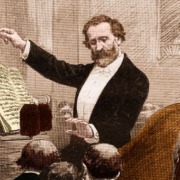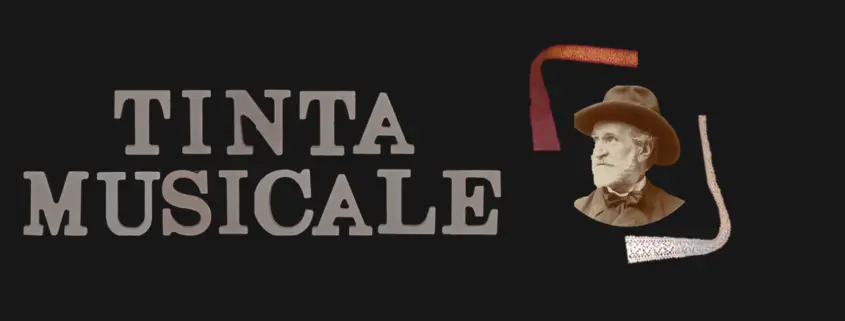Glossary: TINTA MUSICALE
This post shows the technical term TINTA MUSICALE explained in a few sentences with links to practical examples.
What is a tinta musicale?

This term comes from the musical language of Verdi and there is no formal definition for it. What is it about? From the Rigoletto onwards, Verdi equipped his operas with their own BASIC MUSICAL COLOURS and MUSICAL CHARACTERIZATION (rhythmic structures, harmonies, etc.).
In “La traviata”, for example, it was the Waltz rhythms of bourgeois society or in Aida, among other things, the use of a specially developed Aida trumpet (the faranoa’s fanfares). For Verdi the development of the characteristic tinta of an opera was an important part of the composition work, but also a laborious one (“il piu fatticoso lavoro”), because the tinta was strategically developed, it had to support the scenes & plot and reflect the historical embedding of the opera.
Expamples from Verdi’s Operas:
Tinta musicale Nabucco
Noise
The orchestra already attracts attention at the beginning with its volume and the metallic, hard sound. Verdi wrote a noisy music for Nabucco. He loved the sharp accents, which he presents to the listener in this work unrestrained and in a dramatic way.
The role of Abigaille
Abigaille’s music captivates with its obsession, which Verdi documents with wild leaps in tone. Verdi is a Romantic composer and does not stand above his art with classicistic reserve like Rossini, but is a participant; an affected person of the stories he sets to music.
The role of the choir
The choral and mass scenes do not miss their effect on the listener. Contemporary listeners were used to the fact that the choir played a subordinate, accompanying role in the belcantist opera. And now Verdi composes an opera in which the choir has the presence of a leading actor, becomes an important carrier of the dramatic plot and with “Va pensiero” even sings the most famous passage of the whole opera, indeed of the whole history of opera. Much has been written about Verdi’s political and intellectual role in the Italian desire for freedom in the nineteenth century, and how this piece later made him the inspiring composer of the Risorgimento (the Italian freedom movement). Verdi later emphasized that already at the premiere of Nabucco, listeners associated this hymn of the Hebrews with their resistance against the Austrian authorities. The latter statement, however, is historically controversial. Verdi cultivated this myth in detail in his later years.
The “Verdi Bariton”
Another characteristic element of Nabucco is the absence of a tenor protagonist, whose role is filled by Nabucco, a baritone. The “Verdi Baritone” appears for the first time, a role that must develop great dramatic power and is characterized by high vocal flexibility for passages in higher registers. Nabucco does not have to play a tenor in love, but a father without a wife, army commander, opponent of Zaccaria and he has to fight against himself. Verdi will compose later often for this type of baritone.
Link to the Opera portrait Nabucco
Tinta musicale Macbeth
Verdi wrote Macbeth for the impresario Lanari, who was receptive to experiments and gave Verdi the space to create the unusual.
Verdi’s ingenious strategy of giving each opera its own musical colour (he called it “tinta musicale”) paid off in Macbeth to the highest degree. What does the tinta of Macbeth consist of? For one thing, there are the gloomy scenes of madness and witches. On the other hand, the leading roles are not played by the classical tenor and soprano, but by a baritone with a deep voice and dark sound and a mezzo whose voice can produce the darkest colours.
Link to the Opera portrait of Macbeth
Tinta Musicale Rigoletto
The “tinta musicale” of “Rigoletto” is determined by the gloominess of the role and the music of the court jester (somber chords, dotted curse motif, etc.) and the contrast with the courtly gaiety of the Duke (arias in minuet form). In addition, all roles except primo tenore and primo soprano were entrusted to lower voice ranges. A second important aspect of the tinta of Rigoletto is the frequency of the duets. Verdi himself called Rigoletto a “succession of duets”.
Link to the Opera portrait of Rigoletto
Tinta Musicale Traviata
For the many salon scenes he used mainly waltz-like rhythms. He extended this dancing aspect to scenes such as duets etc., the majority of the score is written in triple time. A second characteristic element is the chamber-musical arrangement of the work. Large parts of the opera are arranged in arias or duets; choral scenes and trios appear only very sparsely. A third characteristic element is the use of the love motif which Verdi repeatedly quotes, sometimes in dramatic form (for example in “Amami” in the second act), sometimes in lyrical form (for example in the death scene and in the love duet of the first act). You can see this motif in the commentary to the aria “Ah fors’è lui“.
Link to the operaportrait of Traviata
Tinta Musicale Simon Boccanegra
In this opera, first and foremost, darkness is to be mentioned, which takes place on different levels. It begins with the lighting control, goes to the declamatory style of the voices (at the expense of classical number arias) and the choice of voices: Amelia is the only female voice besides an armada of 6 male voices. Moreover the leading role is not assigned to the tenor or the soprano, but to the so-called Verdi Baritone, a baritone voice with dramatic qualities and stamina for long passages in high tessitura.
Link to the operaportrait Simon Boccanegra
Tinta Musicale Don Carlo
We experience in various scenes that the melancholy mood of the music forms an important part of the tinta musicale of the opera. Also part of the tinta are the many crowd scenes, which make Don Carlo an exceptional work in Verdi’s oeuvre. As a third element, the somberness can be mentioned. Verdi realizes this with the choice of voices. In addition to the baritone of Posa, three basses (Philip, the Grand Inquisitor and the Monk) sing roles.
Link to the operaportrait of Don Carlo
Tinta Musicale Aida
An important basic principle of the tinta of “Aida” was the “varietà”, the contrasting of opposites. On the one hand, there is the love relationship, embodied by Aida and Radames; on the other hand, there is that of the power of the state, embodied by the priests. This tension is complemented by the drama of Amneris. Verdi developed memory motifs for this, which are repeatedly quoted. You will find the love motif and the priest motif in the overture section. In addition, there are two motifs of Amneris.
Another aspect of the “tinta” of “Aida” are the mass scenes. Verdi had the so-called Aida trumpet developed especially for this, which we hear, for example, in the triumphal march. Verdi deliberately used the mass scenes to create a contrast to the many lyrical scenes that we hear, for example, in the poignant duets between Radames and Aida. Another aspect of Tinta is the many duets. While we count a total of only three classical arias (“Celeste Aida”, “Ritorna vincitor” and “O patria”), Verdi wrote six duets, the most famous of which became the final duet “O terra addio”.
Link to the operaportrait of Aida
Peter Lutz, opera-inside, the online opera guide




Leave a Reply
Want to join the discussion?Feel free to contribute!